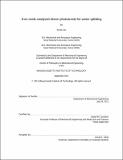Iron-oxide catalyzed silicon photoanode for water splitting
Author(s)
Jun, Kimin
DownloadFull printable version (6.422Mb)
Other Contributors
Massachusetts Institute of Technology. Dept. of Mechanical Engineering.
Advisor
Joseph M. Jacobson.
Terms of use
Metadata
Show full item recordAbstract
This thesis presents an integrated study of high efficiency photoanodes for water splitting using silicon and iron-oxide. The fundamental limitations of silicon to water splitting applications were overcome by an ultrathin iron-oxide film stack and a pH-adjusted electrochemical environment. It was experimentally demonstrated that this functional photoanode has very strong photoactivity exceeding the performance of previously reported systems. A complete theoretical explanation is provided with experimental substantiations. Two major obstacles of the application of silicon to water splitting are its high valence band edge and the lack of catalytic functionality. The solution for band edge mismatch is to facilitate the unique pH response of silicon with respect to electrolyte pH. As opposed to the low pH, a high pH electrolyte allows the silicon valence band edge to be located below the oxygen evolution potential, providing physical platform for the water oxidation reaction. In this platform, the introduction of a thin iron-oxide layer was proved to effectively catalyze the anode reaction which is otherwise impossible. The very thin film enables the separation of the two key functions of the photoelectrode: photocarrier generation and catalysis. Since the iron-oxide film has a very low absorption of incident light, phorocarriers are generated in the silicon layer, while the surface still maintains catalytic functionality. By this functional separation, it was possible to overcome the loss incurred by poor electronic and photovoltaic properties of iron-oxide. The thin semiconducting film also allows a space charge region to span beyond the catalyst layer to silicon, inducing a large built-in potential to lower the required overpotential. Additional improvement was made by adopting silicon microfabrication techniques to maximize light harvesting and minimize potential losses in silicon layer. By vertical wires and ohmic contact formation, the onset potentials were decreased and the current-potential slopes were steepened, resulting in current density as high as 17 mA/cm² at zero overpotential. These results were obtained with two of the most abundant materials, and as such shows the prospect of an efficient solar-driven water splitting pathway. In addition, the comprehensive theoretical explanations will contribute to searching for further system improvements.
Description
Thesis (Ph. D.)--Massachusetts Institute of Technology, Dept. of Mechanical Engineering, 2011. This electronic version was submitted by the student author. The certified thesis is available in the Institute Archives and Special Collections. Cataloged from student submitted PDF version of thesis. Includes bibliographical references (p. 130-139).
Date issued
2011Department
Massachusetts Institute of Technology. Department of Mechanical EngineeringPublisher
Massachusetts Institute of Technology
Keywords
Mechanical Engineering.